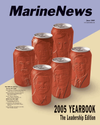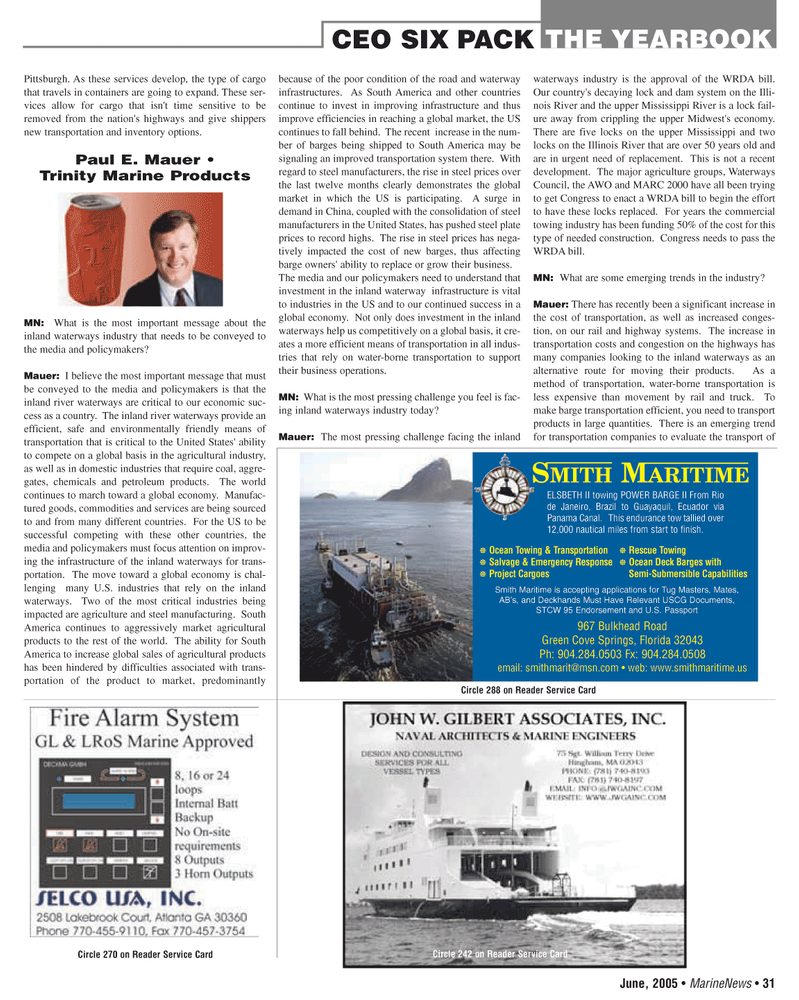
Page 31: of Marine News Magazine (June 2005)
Read this page in Pdf, Flash or Html5 edition of June 2005 Marine News Magazine
Pittsburgh. As these services develop, the type of cargo that travels in containers are going to expand. These ser- vices allow for cargo that isn't time sensitive to be removed from the nation's highways and give shippers new transportation and inventory options.
Paul E. Mauer •
Trinity Marine Products
MN: What is the most important message about the inland waterways industry that needs to be conveyed to the media and policymakers?
Mauer: I believe the most important message that must be conveyed to the media and policymakers is that the inland river waterways are critical to our economic suc- cess as a country. The inland river waterways provide an efficient, safe and environmentally friendly means of transportation that is critical to the United States' ability to compete on a global basis in the agricultural industry, as well as in domestic industries that require coal, aggre- gates, chemicals and petroleum products. The world continues to march toward a global economy. Manufac- tured goods, commodities and services are being sourced to and from many different countries. For the US to be successful competing with these other countries, the media and policymakers must focus attention on improv- ing the infrastructure of the inland waterways for trans- portation. The move toward a global economy is chal- lenging many U.S. industries that rely on the inland waterways. Two of the most critical industries being impacted are agriculture and steel manufacturing. South
America continues to aggressively market agricultural products to the rest of the world. The ability for South
America to increase global sales of agricultural products has been hindered by difficulties associated with trans- portation of the product to market, predominantly because of the poor condition of the road and waterway infrastructures. As South America and other countries continue to invest in improving infrastructure and thus improve efficiencies in reaching a global market, the US continues to fall behind. The recent increase in the num- ber of barges being shipped to South America may be signaling an improved transportation system there. With regard to steel manufacturers, the rise in steel prices over the last twelve months clearly demonstrates the global market in which the US is participating. A surge in demand in China, coupled with the consolidation of steel manufacturers in the United States, has pushed steel plate prices to record highs. The rise in steel prices has nega- tively impacted the cost of new barges, thus affecting barge owners' ability to replace or grow their business.
The media and our policymakers need to understand that investment in the inland waterway infrastructure is vital to industries in the US and to our continued success in a global economy. Not only does investment in the inland waterways help us competitively on a global basis, it cre- ates a more efficient means of transportation in all indus- tries that rely on water-borne transportation to support their business operations.
MN: What is the most pressing challenge you feel is fac- ing inland waterways industry today?
Mauer: The most pressing challenge facing the inland waterways industry is the approval of the WRDA bill.
Our country's decaying lock and dam system on the Illi- nois River and the upper Mississippi River is a lock fail- ure away from crippling the upper Midwest's economy.
There are five locks on the upper Mississippi and two locks on the Illinois River that are over 50 years old and are in urgent need of replacement. This is not a recent development. The major agriculture groups, Waterways
Council, the AWO and MARC 2000 have all been trying to get Congress to enact a WRDA bill to begin the effort to have these locks replaced. For years the commercial towing industry has been funding 50% of the cost for this type of needed construction. Congress needs to pass the
WRDA bill.
MN: What are some emerging trends in the industry?
Mauer: There has recently been a significant increase in the cost of transportation, as well as increased conges- tion, on our rail and highway systems. The increase in transportation costs and congestion on the highways has many companies looking to the inland waterways as an alternative route for moving their products. As a method of transportation, water-borne transportation is less expensive than movement by rail and truck. To make barge transportation efficient, you need to transport products in large quantities. There is an emerging trend for transportation companies to evaluate the transport of wheelOcean Towing & Transportation wheelSalvage & Emergency Response wheelProject Cargoes wheelRescue Towing wheelOcean Deck Barges with
Semi-Submersible Capabilities 967 Bulkhead Road
Green Cove Springs, Florida 32043
Ph: 904.284.0503 Fx: 904.284.0508 email: [email protected] • web: www.smithmaritime.us
ELSBETH II towing POWER BARGE II From Rio de Janeiro, Brazil to Guayaquil, Ecuador via
Panama Canal. This endurance tow tallied over 12,000 nautical miles from start to finish.
SMITH MARITIME
Smith Maritime is accepting applications for Tug Masters, Mates,
AB’s, and Deckhands Must Have Relevant USCG Documents,
STCW 95 Endorsement and U.S. Passport
Circle 270 on Reader Service Card
Circle 288 on Reader Service Card
Circle 242 on Reader Service Card
CEO SIX PACK THE YEARBOOK
June, 2005 • MarineNews • 31
JUNEMN2005 4(25-32).qxd 5/26/2005 2:02 PM Page 31

 30
30

 32
32
